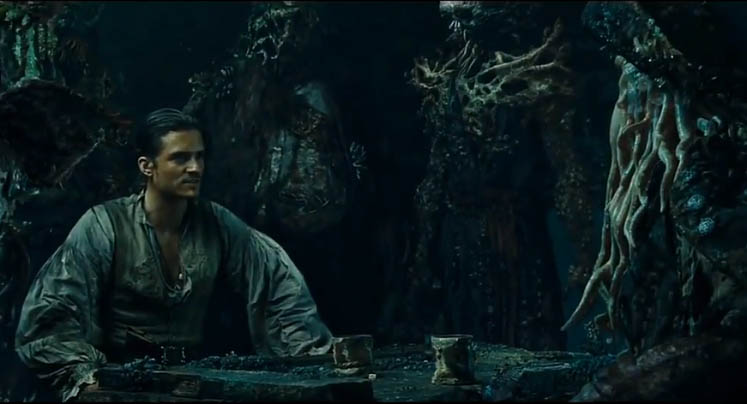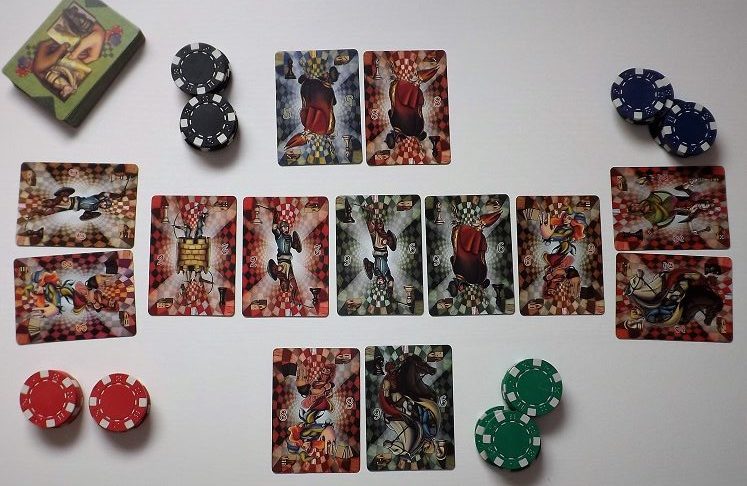PokerGuess
This game is similar to the “Pirates of the Caribbean” dice game, but this time with PokerDrez cards.

In PokerGuess, players will try to guess the maximum number of cards of the same figure and the maximum number of cards of the same color among all participants. To achieve this, they must take into account the bets made by the other players.
Components
It is played with a deck of 56 Pokerdrez cards.
The two neutral cards will not be used in this game.
Poker chips (not included) are used for betting.
Rules
During each hand, each player receives two private cards, and five more are dealt face-up in the center of the table (all at once).
All players cover the initial bet before the round begins.
The first player, taking into account their private cards and the face-up cards, proposes the size of a group of colored cards and the size of another group of figure cards that, AT LEAST, exist (they believe exist) among all their cards, common cards, and opponents’ cards (which they cannot see): all together.
Each card can only be counted in one of the two groups: in the group of its figure or in the group of its color.
After this, they can increase or not increase the existing bet.
The next player, based on what the previous player has said (which may be true or false), their own cards, and the face-up cards, must decide whether to:
- Fold, then their chips go to the pot,
- Cover the bet of the previous player,
- Increase the bet of their predecessor.
In either of the last two cases, the player must make their prediction by indicating a total number of figures and colors among all the cards (as the first player has already done).
This quantity does not necessarily have to be greater than that indicated by the previous player (who may have lied).
The color and figures do not have to be the same as those mentioned by their predecessor, but in no case can a player’s prediction be exactly the same as that of any other player. (It is recommended to write down each player’s predictions)
Players’ turns continue as long as any of them wants to change (not necessarily improve) the number of figures and/or colors mentioned earlier or wants to increase their bet. Other players will have to, at least, cover it to continue in the round.
The game moves to the next phase when none of the players, obligated to cover the last bet, has decided to raise it again or when none of the players has decided to change their prediction. In other words, each change will give the other players the opportunity to adjust their bets or predictions, but it will not allow the player who made the last change to make any additional modifications.
Last card phase
Then, and in turn order, each player will reveal one of their two cards (the one they believe can mislead their opponents the most).
With this new information, following the original order, players can change their previous prediction or increase their bets following the same procedure explained earlier.
End of the game
At the end of this phase, all players reveal their cards. The check will start with the player who made the highest prediction both in quantity and hierarchy (Joker, Queen, Rook, Bishop, Knight, Pawn) or numbers of colors.
If this player’s prediction was correct, they win the round and take the entire pot. Otherwise, they lose their chips, and the next highest prediction is checked.
If none of the predictions is correct, the pot is divided equally among all who reached this final stage of showing the cards.
When a player runs out of chips, they have to leave the game.
The rounds will continue until only one player has won all the chips.

Example
Let’s suppose we have four players (see the image above shared with Poker7):
- The player at the top has a blue bishop and an orange bishop.
- The player on the left has a yellow pawn and a magenta joker.
- The player at the bottom has an orange joker and a green knight.
- The player on the right has a red queen and a red horse.
The community cards are:
- A red tower
- A red pawn
- A green pawn
- A green bishop
- A yellow joker
Combining private cards, community cards, and assuming what other players may have (and have said):
- The player at the top predicts there will be 3 red cards and 4 bishops.
- The player on the left predicts 4 red cards and 4 pawns.
- The one at the bottom, more conservative, predicts there will be 3 green cards and 3 jokers.
- The last player, on the right, predicts there will be 4 red cards and 3 pawns.
- The player at the top, again on their turn, now with the information from the other predictions, decides to change to 4 red cards and 4 bishops.
The other players choose not to change their bets, so the control phase begins, and all players reveal their cards (to simplify the example, we skip the phase of showing the last card).
From the perspective of the size of the two groups, the one on the left and the one at the top are tied with 4 cards in each group. Even the color group, the most significant, is red in both cases, so they are still tied. Finally, in the second group, that of the figures, the one at the top predicted a group of bishops ahead of the group of pawns on the left, so their bet will be the first to be checked.
Their prediction was that there would be 4 red cards, which is true (the two red cards on the right and the two community red cards). They also predicted there would be 4 bishops, but now they can’t use any of the cards they already counted for the first color group. Thus, only the two bishops and the community bishop remain, i.e., only 3, not 4 as predicted, so they lose the bet.
The second-highest prediction was made by the player on the left. The 4 predicted red cards are the same as counted before, but of the 4 predicted pawns, there are only three (the two community ones and their own), but only two can be counted because one was already used in the first group of red cards. This way, they also don’t meet their prediction and lose the bet.
The player on the right has the next highest prediction with their largest group of 4 red cards, which we already know exist. They also predicted there would be 3 pawns, but as we saw earlier, only two are available because the other one was already used in the previous group, so they also lose the bet.
Finally, the prediction of the next player is checked: They predicted 3 green cards that exist (their own and the two community ones). They also predicted 3 jokers, which also exist (they have theirs, one community joker, and the one on the left). Since none of the cards match in color and figure, all are valid in their groups.
Therefore, this last player is the winner of this round, taking the entire pot.

